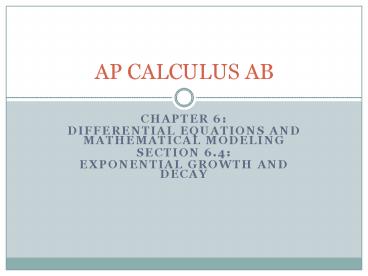Differential Equations and Mathematical Modeling - PowerPoint PPT Presentation
1 / 17
Title:
Differential Equations and Mathematical Modeling
Description:
AP CALCULUS AB CHAPTER 6: DIFFERENTIAL EQUATIONS AND MATHEMATICAL MODELING SECTION 6.4: EXPONENTIAL GROWTH AND DECAY What you ll learn about Separable Differential ... – PowerPoint PPT presentation
Number of Views:1592
Avg rating:3.0/5.0
Title: Differential Equations and Mathematical Modeling
1
AP CALCULUS AB
- Chapter 6
- Differential Equations and Mathematical Modeling
- Section 6.4
- Exponential Growth and Decay
2
What youll learn about
- Separable Differential Equations
- Law of Exponential Change
- Continuously Compounded Interest
- Modeling Growth with Other Bases
- Newtons Law of Cooling
- and why
- Understanding the differential equation
- gives us new insight into exponential growth and
decay.
3
Separable Differential Equation
4
Example Solving by Separation of Variables
5
Section 6.4 Exponential Growth and Decay
- Law of Exponential Change
- If y changes at a rate proportional to the
amount present - and y y0 when t 0,
- then
- where kgt0 represents growth and klt0 represents
decay. - The number k is the rate constant of the
equation.
6
Section 6.4 Exponential Growth and Decay
- From Larson Exponential Growth and Decay Model
- If y is a differentiable function of t such that
ygt0 and ykt, for some constant k, then - where C initial value of y, and
- k constant of proportionality
- (see proof next slide)
7
Section 6.4 Exponential Growth and Decay
- Derivation of this formula
8
Section 6.4 Exponential Growth and Decay
- This corresponds with the formula for
Continuously Compounded Interest - This also corresponds to the formula for
radioactive decay
9
Continuously Compounded Interest
10
Example Compounding Interest Continuously
11
Example Finding Half-Life
Hint When will the quantity be half as much?
12
Section 6.4 Exponential Growth and Decay
- The formula for Derivation
- half-life of a
- radioactive
- substance is
13
Newtons Law of Cooling
14
Section 6.4 Exponential Growth and Decay
- Another version of Newtons Law of Cooling
- (where Htemp of object
- Ttemp of outside medium)
15
Example Using Newtons Law of Cooling
16
Example Using Newtons Law of Cooling
Use time for L1 and T-Ts for L2 to fit an
exponential regression equation to the data.
This formula is T-Ts.
17
Section 6.4 Exponential Growth and Decay
- Resistance Proportional to Velocity
- It is reasonable to assume that, other forces
being absent, the resistance encountered by a
moving object, such as a car coasting to a stop,
is proportional to the objects velocity. - The resisting force opposing the motion is
- We can express that the resisting force is
proportional to velocity by writing - This is a differential equation of exponential
change,































